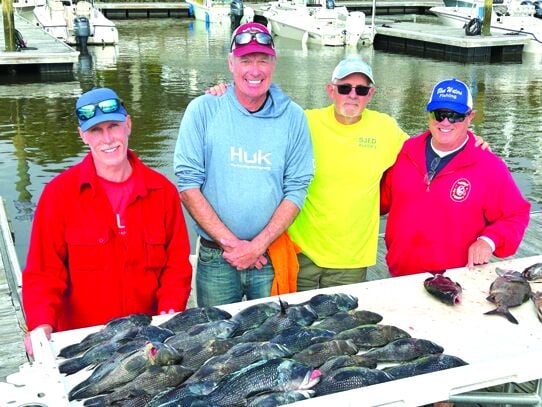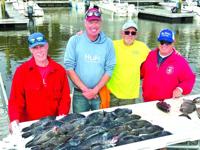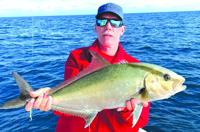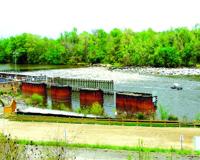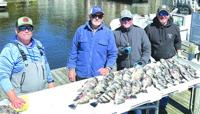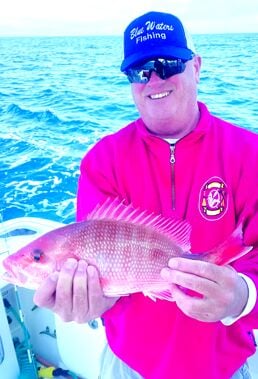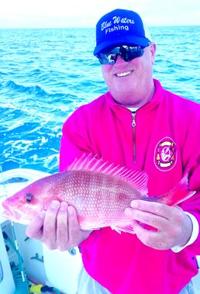Well, March is drawing to its end and things in our fishing world have progressed pretty well. The hours of daylight are increasing, plus Daylight Saving Time has started and there is an extra hour of daylight in the afternoon, spring has sprung and we didn’t get stabbed by a friend on the Ides of March. Well, not unless you consider the Marine Fisheries Commission’s decision to lower the speckled trout limit a slice from an unfriendly knife. By this time next week, we’ll be in April and looking even more forward to warm days with extra sunshine and hungry fish.
MRC meeting: I’ll go ahead and talk about the Marine Fisheries Commission meeting first. This meeting had been postponed from February because of one of the nasty cold snaps we have endured this year and was eagerly, but not necessarily positively, anticipated by all. The Commission did most of what was expected with speckled trout. It dropped the recreational limit from four fish to three fish and established a slot size of 14-20 inches. There was a one-fish exemption to the slot size included if the fish was longer than 26 inches. The season closure time after cold stun and kill events was increased 15 days from June 15 to June 30. The draft of this removed the guide’s limit when on a charter, but the regulations that passed gave it back.
The slot limit was removed from the draft of commercial fishing recommendations and this is probably good to prevent wasted fish. The commercial reduction is expected to be achieved through a Saturday and Sunday closure from January to September and a Saturday, Sunday and Monday closure from October to December. This closure corresponds to a closure in the striped mullet fishery. There is ongoing discussion regarding stop nets for commercial fishing and adaptive management for commercial and recreational fishing.
The speckled trout season is currently closed. Expectations are to see a proclamation soon that the 2025 season will reopen on July 1 with the new limits.
Some potential good news from this meeting is that the MFC took a step towards adoption of draft Southern Flounder Fishery Management Plan Amendment 4 by approving the draft plan for public and advisory committee review. Draft Amendment 4 would move the already scheduled sector allocation shift to 50/50 (commercial/recreational) from Amendment 3 up by one year to 2025 instead of 2026.
Amendment 3, adopted in 2022, prescribed a shift in quota allocation from 70/30 (commercial/recreational) to 60/40 in 2025 and 50/50 in 2026. This was a delayed shift from the original Amendment which had the quota allocation as 60/40 in 2024 and 50/50 in 2025, so it’s really just a shift back to the original Southern Flounder FMP Amendment. This move was brought about following two years with short recreational flounder seasons and one year with no recreational flounder season. The MFC Commissioners still anticipate this to only be a short (two week or one month) season and tasked the Division of Marine Fisheries with finding ways to allow more recreational access while maintaining the stock rebuilding requirements in Amendment 3.
More long-term, comprehensive options for recreational access will be considered in Amendment 5, which is currently under development. A scoping period on Amendment 5 is open until March 31, with the last public meeting to be held at Cape Fear Community College on March 27 from 6 to 8:00 p.m. More information is available at https://www.deq.nc.gov/information-southern-flounder-amendment-5. We should see a schedule at any time of when the Amendment 4 meetings will be held by the advisory committees.
Speckled trout season remains open in Inland Waters and the Wildlife Resources Commission says also in Joint Waters by hook and line fishing. However, there is disagreement with the Marine Fisheries Commission on the Joint Waters season. Fishermen must remember is that it is illegal to cross waters carrying fish that aren’t legal in those waters, so fishermen taking advantage of the open trout season in Inland Waters can’t ride home through Coastal Waters with their catch.
A big difference between the Division of Marine Fisheries and the Wildlife Resources Commission is that the director of the DMF has proclamation authority and can alter the season and/or regulations with a 48 hour notice. The director of the Wildlife Resources Commission doesn’t have this authority. The DMF was formed primarily to deal with commercial fishing and its director was granted proclamation authority to be able to close seasons if the allocation was caught early. There isn’t commercial fishing in Inland waters, so the WRC was set up to only make changes annually. It requires a legislative review for the WRC to change a season or limit.
At their February 5-6 meeting, the WRC commissioners discussed the speckled trout situation and closure issued by the DMF and voted to notice a temporary rule that would close the recreational harvest of spotted seatrout in Inland and Joint Waters from May 1 through June 15. This rule is currently under legislative and legal review and hasn’t met final approval yet.
“Because the Wildlife Commission does not have proclamation authority and we have to work through the rulemaking process, the earliest this would be effective is May 1, 2025,” said Chief Deputy Director Christian Waters. “Anglers concerned about spotted seatrout mortality may want to target other species.”
FYI for any fishermen heading to the Roanoke River for the annual striper run: The executive director of the Wildlife Resources Commission issued a proclamation in late February that the Roanoke River would be closed to striped bass harvest again in 2025. There are details of this closure below.
The Wildlife Resources Commission is also warning people about spring encounters with animals. In a nutshell, their advice is to give them plenty of room and leave them alone. The mother of that cute fawn or bear cub is probably close by and will most likely be upset if you try to “help” it. There is a document on the WRC website at https://www.ncwildlife.gov/news/press-releases/2025/03/13/wildlife-agency-offers-guidance-animal-encounters-increase-spring that offers suggestions for avoiding negative animal encounters while the potential for them increases during the spring.
There are separate links for encounters with bears (https://bearwise.org/make-it-a-bearwise-spring/) and bear cubs (https://www.ncwildlife.gov/news/press-releases/2025/03/18/keep-your-distance-those-bear-cubs), plus snakes (https://www.ncwildlife.gov/catalog-category/reptiles-snakes), coyotes (https://www.ncwildlife.gov/species/coyote), foxes (https://www.ncwildlife.gov/media/2181/download?attachment), bats (https://www.ncwildlife.gov/media/1386/download?attachment) and more.
Some basic rules that apply to all wildlife encounters include:
• Never feed or handle a wild animal.
• Leave a young animal where it’s found because wild parents rarely abandon their young, even if they detect human scent.
If unsure as to whether an animal needs human assistance or to answer questions about wildlife removal contact NCWRC’s Wildlife Helpline, Monday through Friday, 8 a.m. – 5 p.m., at 866-318-2401 or by email, HWI@ncwildlife.gov.
Fishermen, boaters and hunters should be aware that the URL for the Wildlife Resources Commission website has changed. It is now www.ncwildlife.gov. A spokesman for the Commission said the old URL will continue to work for a while and seamlessly transfer visitors to the new internet location.
Senate Bill 220: There is one more rule, regulation or law to point out this month. Shortly after our last Scales and Tales in February, Senate Bill 220 was introduced. Much of this bill had been requested by the Wildlife Resources Commission, but there was Section 4 that would make it illegal to launch any watercraft, canoe, kayak, SUP or whatever from the right-of-way beside a road and the Wildlife Resources Commission hadn’t requested this. This created an immediate uproar and numerous groups and concerned people started petitions to be sent to the legislators to not support this bill.
I exchanged emails with our State Rep. Charlie Miller regarding SB 220, Section 4 and he assured me he was opposed to it and had already spoken to many of his colleagues regarding it. I also sent an email to State Sen. Bill Rabon’s office, but did not receive a reply. Senator Rabon was a sponsor of the bill.
At my last check of SB 220 at the N.C. Legislature website, (https://www.ncleg.gov/Sessions/2025/Bills/Senate/PDF/S220v1.pdf), Section 4 was still included and the wording had not been changed. However, I have been told that the amount of immediate resistance to Section 4 of SB 220 got the attention of our legislators and it will be removed before the bill is voted on. I trust this is indeed the case and, if so, it’s nice to see our lawmakers respond to the public like this.
Water temps: With the sunshine and warm days during March, water temperatures are trying to get back to their normal ranges for early spring. The January and February freezes chilled them into the lower-40s but they have rebounded into the mid-50s with several reporting stations approaching 60. Several fishermen reported the water temps well back in area creeks had warmed into the 60s, so the water is warming. Hopefully, we’re done with the really cold weather for this winter and the water temps will continue to rise. We always hope for the lower 60s by the beginning of April and we’re almost there. Interested fishermen can check water temperatures for themselves by visiting the Coastal Ocean Research Monitoring Program website (www.cormp.org).
Water temps and weather are related and I thought it was unusual that the National Hurricane Center felt serious enough about a low with some circulation to mention it the third week of March. Thankfully this one didn’t develop, but dissipated pretty quickly. We certainly can do without another no-name early spring storm like the one of March 12, 1993.
Locks and dams: I made a small pilgrimage during March to shake off the cobwebs accumulated by staying indoors over the winter and headed up the Cape Fear River to visit the locks and dams between Wilmington and Fayetteville. The thoughts of shad fishing brought this on, but it’s also a check to see if the river is anywhere close to regaining it’s claim as a great place to catch stripers.
In the early 1900s, the Cape Fear River was one of the top five striper rivers on the east coast. Then the Corps of Engineers began damming parts of the river and installing locks to allow barge commerce to Fayetteville and the great striper fishing slowed. The number of stripers in the river began to wane as they couldn’t reach their spawning grounds, which were upriver from Fayetteville. Fish ladders had been discussed as a way around the dams, but none had been installed.
There are three lock and dam sites on the Cape Fear between Wilmington and Fayetteville. The locks are functional, but require an appointment for passage. All have boat ramps and picnic shelters.
Lock and Dam No. 1 is a few miles upriver from Riegelwood and finally received its fish ladder about 15 years ago. It was installed incorrectly on the first try and had to be redone, but it is in place. However, there still are not fish ladders at Lock and Dam No. 2, near Elizabethtown, and the John O Huske Lock and Dam (Lock and Dam No. 3), a few miles upriver from Tar Heel.
My pilgrimage showed a few fishermen trying their luck for shad at Lock and Dam Number 1, but I didn’t see a lot of action. One fisherman was soaking a couple of baits for catfish at Lock and Dam No. 2, but hadn’t caught one yet and didn’t while I was there. There weren’t any fishermen at Lock and Dam No. 3, but there was an empty trailer in the boat ramp parking, so there was a fisherman somewhere on the river between Lock and Dams 2 and 3.
There have been several attempts at stocking the river with striper, but most of the fingerlings have been from stripers caught in other areas and the success has been limited. A few stripers work through the locks each spring, so there is some natural reproduction, but it is restrained. There have been discussion on removing the two dams without fish ladders to restore unlimited upriver access to the fish, but several municipalities draw their drinking water from the ponds just above the dams and the water level would drop below their intakes without the dams in place.
There has been a moratorium on keeping stripers in the Cape Fear River system for about 20 years, but the numbers remain low, however pretty stable. I caught stripers we could keep in the river as a youngster and would like to see that option return. I think fish ladders at Lock and Dam No. 2 and 3 are a step in the right direction and may even be enough to solve the problem. Hopefully a group with enough clout and funding will get behind this and make it happen – and it needs to happen in the near future.
If you’ve missed Scales and Tales in several issues, relax, we haven’t gone anywhere. We have been on our winter schedule when Scales and Tales runs monthly, on the last Wednesday of the month. This is the last of the monthly pages. We’ll be back weekly beginning April 16.
We want pictures of our readers with fish they have caught, so remember to send pictures of your catches that make you smile. They’ll make us and your friends smile too. When you catch those big fish, take a picture with your phone or camera and email it to us at sports@stateportpilot.com or captjerry@captjerry.com. It’s a great way to share your good catches with friends and family and we enjoy highlighting reader catches.
The Fishing Report
The big and unusual news from March was the 13-foot great white shark that was caught while surf fishing at the Outer Banks in mid-March. From watching the travels of the tagged great whites on the Ocearch website (www.ocearch.com), it was known that the big fish, usually considered ocean predators, sometimes cruised very close to ocean beaches and occasionally entered rivers and sounds. Numerous fishermen thought there were great whites following schools of bluefin tuna and occasionally getting close to the beach and this catch removes any doubt.
One of the first documented cases of a great white shark nearing shore or entering a river was when the female great white shark named Mary Lee entered the Cape Fear River in late November of 2012. At that time, Mary Lee was a 16 foot long, 3,400 pound female great white. She had been tagged by Ocearch (www.ocearch.org) off Cape Cod on September 17, 2012. She worked her way south to off Fernandina Beach, Florida, before turning back north and investigating the Cape Fear.
This isn’t a fishing report as such, as it wasn’t caught, but it’s also big and unusual. A killer whale was also spotted off the Outer Banks during the middle of March. That’s right, an orca. They aren’t native to anywhere near the Outer Banks, so this is a very unusual sighting. Most reports herald this sighting as the first time ever.
There was a lot of windy weather during March and it prevented fishermen from heading offshore with any regularity. Those fishermen who had flexible time and were ready to take advantage of the calm days returned with fish – and both the weather and fishing will continue to improve.
While most of the seasons for grouper found in less than 150 feet of water were closed, many fishermen still headed offshore whenever the sea conditions allowed to fill fish boxes with the tasty bottom fish who could be invited home for dinner. Their catches were heavy with black sea bass and also included an assortment of grunts, porgys, beeliners, amberjack, African pompano and more. By the middle of March, some really big black sea bass, with humped up heads that were green, purple and other colors were favorites. The humped up and colorful heads have some significance in spawning, but what we know is they are also aggressively feeding and taste good.
There had been a few wahoo and blackfin tuna caught all winter and the numbers slowly began to increase during March. The numbers of these fish, plus so dolphin and a few yellowfin tuna should join the catches during April. All that’s required is a weather window large enough to run 60 miles to the Gulf Stream for a day of trolling and guessing the correct place these pelagic fish will be on that day.
Some fishermen are good at guessing when the offshore fish will be on any given day, while others study the free oceanic water thermal and condition charts provided by agencies such as Rutgers University Institute Department of Marine and Coastal Science (https://marine.rutgers.edu). Still others pay for a subscription service where the ocean conditions, thermal currents and more are studied each day and a team of scientists and biologists predict where the fish will be on any given day. ROFFS (Roffer’s Ocean Fishing Forecasting Service, https://roffs.com) was the pioneer of this service and remains one of the best. However you go at it, the more information you can have helps improve your chances of connecting with pelagic gamefish cruising the temperature breaks and eddies along the Gulf Stream.
King mackerel were still well offshore or still relaxing off South Florida during March, but will begin moving towards and up the beaches during April. Water temperature and an abundance of forage fish are the keys to how quickly or slowly this happens. There have been years when the first pier kings were caught by mid-April and there have been years it seemed to take until almost Memorial Day for them to make their first appearance. With plenty of baitfish and warming water it happens sooner and with chilly water and sparse baitfish, the kings stay offshore and farther south longer.
Surf and pier fishermen have been catching a few scattered red drum, black drum and speckled trout all winter, but they’ve been scattered enough catching one wasn’t anything to plan dinner around. Well, their numbers have experienced a slight uptick, but speckled trout season is closed, so they must be released. Whiting (sea mullet, Va. Mullet) and pufferfish (blowfish) began joining the pier and surf catch during March and their numbers are increasing.
The transition to fishing inside the inlets has to come up or down the beaches to the inlets and whiting have been the stars there. There have been whiting on the flats from Jaybird Shoals to the Hot Hole for a couple of weeks. Look for locations with softer bottom in 12 to 16 feet of water. The sizes are mixed, but there are some nice ones in the mix.
Whiting are also biting on the slopes of the Cape Fear River Ship Channel as it runs by Bald Head and Fort Caswell. The good depths have ranged from about 12 feet down to about 20 feet. They come through in waves, so if you hit a lull, sit it out and wait for the next wave of them to come through.
Fishing inside the inlets has been surprisingly consistent, especially with red and black drum. That’s a good thing too as flounder and speckled trout seasons are closed. There have been a few reports of winter flounder, but it’s really early for them. Many of the flounder reports also say the flounder are really thin from barely eating or eating poorly all winter.
Potential good news for flounder fishermen is that Amendment 4 to the Southern Flounder Fishery Management will be sent to the advisory committees and DMF legal for review. The only thing in this amendment is switching the recreational/commercial allocation to 50/50 this year. This could pass in time to see a flounder season for 2025. My sources say not to expect too much though. The early thinking is 2 weeks to a month with a single flounder limit.
The new regulations on speckled trout were approved at the March MFC meeting. The accompanying proclamation hasn’t been issued yet, but the cold stun/kill closure will be extended through the end of June. When the season reopens, the daily limit will be three trout with a slot limit of 14 to 20 inches. There is a provision that one of these three may be a trophy trout of 26 inches or longer.
Trout are biting, but aren’t the best fish to target for catch and release. If you catch one, handle it gently, but firmly, remove the hook(s) with as little damage as possible and get it back into the water quickly.
This brings us to drum. Red and black drum have been biting well. They may feed together early in the morning, but as the sun rises, red drum often stay in shallower water, while black drum usually move to deeper water. Both will readily eat live baits and respond to dead natural baits pretty well too. Black drum aren’t particularly fond of lures, but red drum will hit a variety of soft and hard lures.
Speaking of live baits, it’s still a bit early for the tackle shops to have live shrimp, but they want them as badly as fishermen and will have them as soon as they are available. Most tackle shops have mud minnows. Several enterprising fishermen said they are catching their own live shrimp, but it can be a tedious process. The shrimp are in deeper holes in the creeks and they are throwing cast nets. The catches aren’t counted in dozens, but in individual shrimp, so it takes a lot of throws.
With the season closures and limit reductions on many fish, a lot of fishermen have turned to sheepshead. The reports are there have been sheepshead around all winter, with occasional good catches and some large fish. This is fishing with a serious learning curve to feel the subtle bites, but the rewards are worth the effort. Sheepshead fight hard and taste really good.
We don’t think of stripers too often, but there are stripers in the Cape Fear River system. Occasionally a few are caught in the lower Cape Fear River, ICW, Davis Canal or Lockwood Folly River, but the primary location in our area tends to be from where the power lines cross the river near Town Creek to a few miles above downtown Wilmington in the Cape Fear and Northeast Cape Fear River and the creeks off them. Stripers handle catch and release well and that’s a good thing. There has been a moratorium on keeping Cape Fear River system stripers for about 20 years.
Stripers that are feeding in and around the mouths of the creeks that run into the rivers usually respond well to soft plastic jerk baits fished fairly slowly. Stripers also like vertical structure in deeper water and respond well to big lipped diving lures along bridge abutments and along the many docks in the area. They will also eat live baits and occasionally chunks of cut bait. Most of these stripers range from a couple of pounds to around 6 pounds, but occasionally a double digit line stretcher grabs the lure first.
There are also shad in the Cape Fear River, but they are caught farther upriver. Some shad may go up the Northeast Cape Fear, but most reports come from the Cape Fear River and typically just below the locks and dams. Lock and Dam Number 1, a few miles upriver from Riegelwood, is the closest place with good reports. There is a fishing structure and a launching ramp there.
The shad run includes the smaller hickory shad and the larger American shad. Both run hard and often jump, with some folks calling them “poor man’s tarpon.” The standard tackle for both shad is ultralight and light rods and reels, casting small spoons (000 and 0000 size) and shad darts. A “no alibi” rig is a tandem rig using both a spoon and a shad dart. A local favorite rig is a tandem rig of 1 or 2 inch curltail grubs in chartreuse and lime green.
I visited Lock and Dam Number 1 a few weeks ago and the shad action was slow. They were catching a few, but that’s all. One fisherman I spoke with said the run hadn’t really gotten going yet. I didn’t receive a report this week, but maybe the shad action has improved.
Scales and Tales likes to fill the page with pictures from readers. Send those pictures of you smiling wide and holding your latest catch to us at sports@stateportpilot.com or captjerry@captjerry.com. Include a few details of your catch and we’ll gladly share them with all our readers.
Good fishing!



